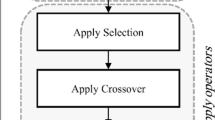Abstract
Random amplified polymorphism DNA (RAPD) analysis is a widely used technique in studying genetic relationships between individuals, in which processing the underlying images is a quite difficult problem, affected by various factors. Among these factors, noise and distortion affect the quality of images, and subsequently, accuracy in interpreting the data. We propose a method for processing RAPD images that allows to improve their quality and thereof, augmenting biological conclusions. This work presents a twofold objective that attacks the problem by considering two noise sources: band distortion and lane misalignment in the images. Genetic algorithms have shown good results in treating difficult problems, and the results obtained by using them in this particular problem support these directions for future work.
Preview
Unable to display preview. Download preview PDF.
Similar content being viewed by others
References
Bio Rad Laboratories: Quantity One User’s Guide. Bio-Rad Laboratories (2000), Electronically, http://www.calpoly.edu/bio/ubl/equip.files/q1.manual.pdf
Burger, W.: Digital Image Processing with Java and ImageJ. Springer, Heidelberg (2006)
Cao, W., Scoles, G., Hucl, P., Chibbar, R.: Philogenetic Relationships of Five Morphological Group of Hexaploid wheat Based on RAPD Analysis. Genome 43, 724–727 (2000)
Casasoli, M., Mattioni, C., Cherubini, M., Villani, F.: A Genetic Linkage Map of European Chestnut (Castanea Sativa Mill.) Nased on RAPD, ISSR and Isozime Markers. Theoretical Applied Genetics 102, 1190–1199 (2001)
Das, R., Laederach, A.: GelQuant User’s Manual. Stanford University (2004), Electronically, http://safa.stanford.edu/release/GelQuantGuiv09B3UserGuide.pdf
Fernandez, M., Valenzuela, S., Balocchi, C.: RAPDs and Freezing Resistance in Eucalyptus Globulus. Electronic Journal of Biotechnology 9, 303–309 (2006)
Floreano, D., Mattiussi, C.: Bio-Inspired Artificial Intelligence. Theories, Methods, and Technologies. MIT Press, Cambridge (2008)
Groos, C., Gay, G., Perrenant, M., Gervais, L., Bernard, M., Dedryver, F., Charmet, G.: Study of the Relationships Between Pre-harvest Sprouting and Grain Color by Quantitative Trait Loci Analysis in the White X Red Grain Bread-wheat Cross. Theoretical Applied Genetics 104, 39–47 (2002)
Herrera, R., Cares, V., Wilkinson, M., Caligarip, D.: Characterization of Genetic Variations Between Vitis vinifera Cultivars from Central Chile Using RAPD and Inter Simple Sequence Repeat Markers. Euphytica 124, 139–145 (2002)
Nkongolo, K.: RAPD Variations Amount Pure and Hybrid Population of Picea Mariana, P. Rubens and P. Glauca and Cytogenetic Stability of Picea hybrids: Identification of Species- Specific RAPD Makers. Plan System Evolution 215, 229–293 (1999)
Rueda, L., Uyarte, O., Valenzuela, S., Rodriguez, J.: Processing Random Amplified Polymorphism DNA Images Using the Radon Transform and Mathematical Morphology. In: Kamel, M.S., Campilho, A. (eds.) ICIAR 2007. LNCS, vol. 4633, pp. 1071–1081. Springer, Heidelberg (2007)
Saal, B., Struss, D.: RGA-and RAPD-derived SCAR Markers for a Brassica B-Genome Introgression Conferring Resistance to Blackleg Oil Seed in Oil Seed Rape. Theoretical Applied Genetics 111, 281–290 (2005)
Sudapak, M., Akkaya, M., Kence, A.: Analysis of Genetic Relationships Among Perennial and Annual Cicer Species Growing in Turkey Using RAPD Markers. Theoretical Applied Genetics 105, 1220–1228 (2002)
Tripathi, S., Mathish, N., Gurumurthi, K.: Use of Genetic Markers in the Management of Micropropagated Eucalyptus Germplasm. New Forests 31, 361–372 (2006)
Williams, J., Kubelik, A., Livak, K., Rafalsky, J., Tingey, S.: DNA Polymorphism Amplified by Arbitrary Primers Useful as Genetic Markers. Nucleic Acid Research 18, 6531–6535 (1990)
Author information
Authors and Affiliations
Editor information
Editors and Affiliations
Rights and permissions
Copyright information
© 2009 Springer-Verlag Berlin Heidelberg
About this paper
Cite this paper
Pinninghoff J., M.A., A., R.C., Rueda, L. (2009). An Evolutionary Approach for Correcting Random Amplified Polymorphism DNA Images. In: Mira, J., Ferrández, J.M., Álvarez, J.R., de la Paz, F., Toledo, F.J. (eds) Bioinspired Applications in Artificial and Natural Computation. IWINAC 2009. Lecture Notes in Computer Science, vol 5602. Springer, Berlin, Heidelberg. https://doi.org/10.1007/978-3-642-02267-8_50
Download citation
DOI: https://doi.org/10.1007/978-3-642-02267-8_50
Publisher Name: Springer, Berlin, Heidelberg
Print ISBN: 978-3-642-02266-1
Online ISBN: 978-3-642-02267-8
eBook Packages: Computer ScienceComputer Science (R0)




